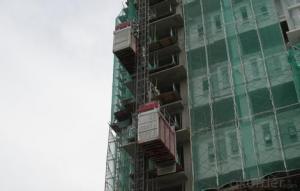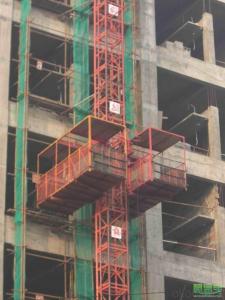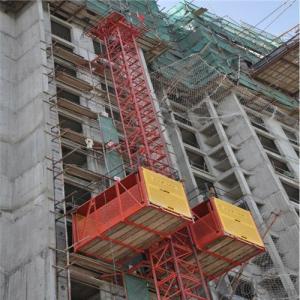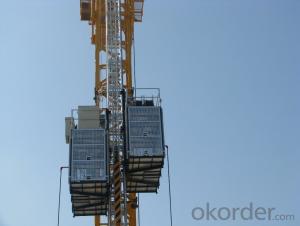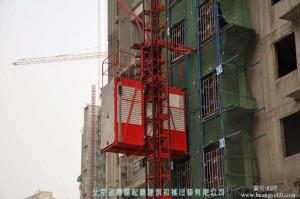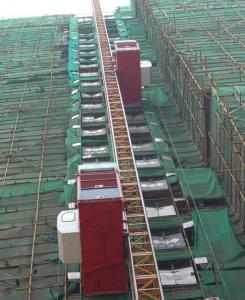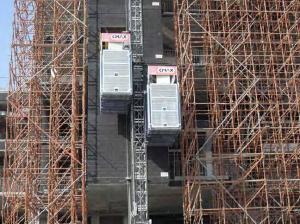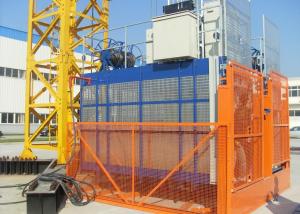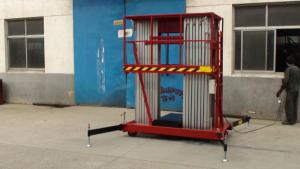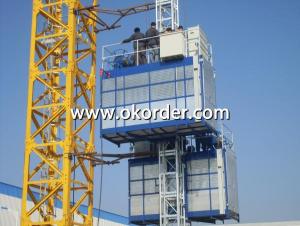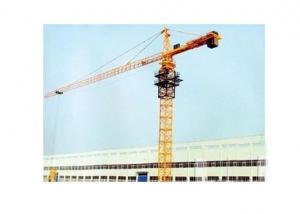Construction Hoist SC270/270 heavy Machinery
- Loading Port:
- China main port
- Payment Terms:
- TT or LC
- Min Order Qty:
- 1 unit
- Supply Capability:
- 30 unit/month
OKorder Service Pledge
OKorder Financial Service
You Might Also Like
Structure of Construction Hoist Description
1.Feature: Construction Hoist
2.Payload(kg):2*2700
3.Lifting Speed(m/min):33
4.Motor Power(kw): 2*3*15
5.Safety Device: 2*SAJ50-1.2
6.Cage: Twin
7.Counterweight: No
8.Certification: CE,ISO
9.Place of Origin: China(Mainland)
10.Model Number: Type:SC270/270
Packaging & Delivery of Construction Hoist
Packaging Detail: Nude package Delivery Detail: 25-30days
Main Parts of Construction Hoist
● The gearing adopts imported bearing, enameled cable, and oil seal.
● The electric parts adopt products from world renowned manufactures such as Schneider, Siemens, and LG.
● The racks and pinion adopts special material and heat-treatment technique, which prolong the life of these parts.
● The steel structure uses quality steel from famous domestic manufactures.
● The surface of the structure can apply paint-spray, parkerozing baking finish or hot galvanizing processing according
to users requirements,
● The cage can be produced and decorated by aluminum molded board, punched-plate or figured aluminm board.
Construction Hoist Specifiction
Single cage High speed
Model | Speed(m/min) | Deadweight(kg) | Motor(KW) | Counterweight | Specification(L×W×H)(m) |
SC100G | 96 | 1000 | 3×22 | No | 2.5×1.3×2.5 |
SC120G | 96 | 1200 | 3×22 | NO | 3.0×1.3×2.5 |
SCD200G | 96 | 2000 | 3×15 | Have | 3.2×1.5×2.5 |
SC200G | 96 | 2250 | 3×22 | No | 3.2×1.5×2.5 |
SC270GS | 96 | 2700 | 3×22 | No | 3.8×1.5×2.5 |
SCD270G | 96 | 2700 | 3×18.5 | Have | 3.8×1.5×2.5 |
SCD300G | 96 | 3000 | 3×22 | Have | 4.0×1.5×2.5 |
SCD320GS | 96 | 3200 | 3×22 | Have | 4.2×1.5×2.5 |
Single cage Medium speed
SC100GZ | 63 | 1000 | 3×15 | No | 2.5×1.3×2.5 |
SC120GZ | 63 | 1200 | 3×15 | No | 3.0×1.3×2.5 |
SCD200GZ | 63 | 2000 | 2×15 | Have | 3.0×1.3×2.5 |
SC200GZ | 63 | 2000 | 3×18.5 | No | 3.0×1.3×2.5 |
SC225GZ | 63 | 2250 | 2×18.5 | No | 3.2×1.5×2.5 |
SC225GZ | 63 | 2250 | 3×18.5 | Have | 3.6×1.5×2.5 |
SCD250GZ | 63 | 2500 | 2×18.5 | Have | 3.6×1.5×2.5 |
SC250GZ | 63 | 2500 | 3×18.5 | Have | 3.8×1.5×2.5 |
SCD270GZ | 63 | 2700 | 2×18.5 | Have | 3.8×1.5×2.5 |
SC270GZ | 63 | 2700 | 3×22 | NO | 4.0×1.5×2.5 |
SCD300GZ | 63 | 3000 | 3×15 | Have | 4.0×1.5×2.5 |
SCD320GZ | 63 | 3200 | 3×15 | Have | 4.2×1.5×2.5 |
Single cage standard speed
SC100TD | 36 | 1000 | 2×11 | NO | 2.5×1.3×2.5 |
SC120TD | 36 | 1200 | 2×11 | NO | 3.0×1.3×2.5 |
SC200TD | 36 | 2000 | 3×11 | NO | 3.0×1.3×2.5 |
SCD200TD | 36 | 2000 | 2×11 | Have | 3.2×1.5×2.5 |
SC270TD | 36 | 2700 | 3×15 | NO | 3.6×1.5×2.5 |
SCD270TD | 36 | 2700 | 2×11 | Have | 3.8×1.5×2.5 |
SC320TD | 36 | 3200 | 3×18.5 | NO | 4.0×1.5×2.5 |
SCD320TD | 36 | 3200 | 2×11 | Have | 4.2×1.5×2.5 |
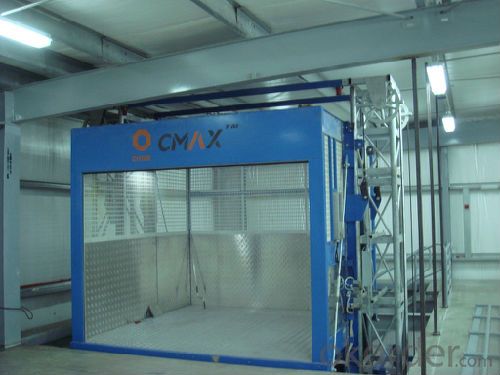
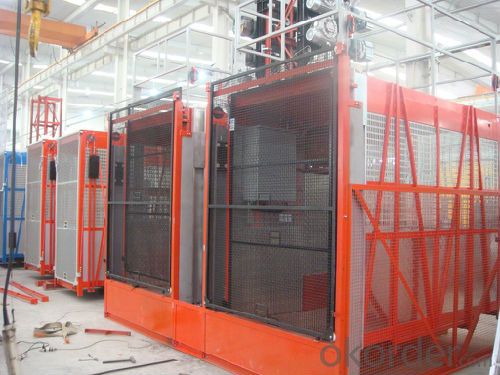


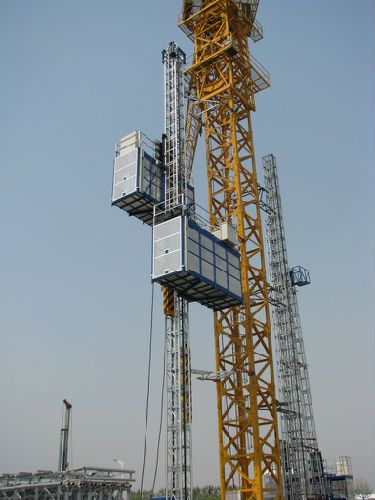
FAQ of Construction Hoist
Q: What is the building hoist main purpose?
A: Building hoist equipped with double or single cabin to transport the materials and labors up and down. It's the ideal
construction equipment for vertical transportation in the field of construction.
Q: What is the main structure of building hoist?
A: The P/M construction hoist mainly contains metal structure, driving system, electrical control system, cable guide &
protection system, electrical top crane and safety device.
Q: What is the meaning of the building hoist’s code?
A: Take SC200/200 for example: “SC” stands for rack and pinion hoist, “200/200” stands for double cage and capacity
is 2 tons per cage. “SC200” stands for single cage and capacity is 2 tons.
Q: What is the dimension of the cage?
A: Normally the cage dimension is 3X1.5X2.5M (L/W/H) for 2t type hoist. Details should be checked according to our
quotation sheet. Also, the size can be customized according to the factual site condition. There are two doors (entrance
& exit doors) for each cage, It can be produced as up & down sliding or ramping model for safety and convenience.
- Q: Is it possible to utilize a building hoist for the purpose of lifting small tools and equipment?
- <p>Yes, a building hoist can be used for lifting small tools and equipment, provided it is within the hoist's weight capacity. It's important to ensure that the items are securely fastened to prevent any accidents during lifting. Always follow the manufacturer's guidelines and safety regulations when using a building hoist for any lifting tasks.</p>
- Q: This question asks for the method to adjust the tension of ropes or cables in lifting equipment such as a building hoist.
- <p>Adjusting the tension on ropes or cables in lifting equipment like a building hoist involves several steps. First, ensure the equipment is turned off and secured to prevent any accidents. Then, locate the tensioning mechanism, which could be a ratchet, turnbuckle, or a similar device. Gradually adjust the mechanism to tighten or loosen the cable as needed. Use a tension meter to measure the tension and ensure it meets the manufacturer's specifications. Regularly inspect the cables for wear and damage, and replace them if necessary. Always follow the equipment's manual for specific instructions and safety guidelines.</p>
- Q: Is it permissible to use a building hoist for the purpose of lifting hazardous materials?
- <p>A building hoist is typically not designed for lifting dangerous materials. It is meant for the transportation of construction materials and personnel within a building. Lifting hazardous materials requires specialized equipment and procedures to ensure safety. Always refer to the manufacturer's guidelines and local regulations for the appropriate use of hoisting equipment and handling of dangerous materials.</p>
- Q: Where is the location of the elevator in the project
- The position of construction elevator is usually set in the project to facilitate access to material, material handling and personnel up and down, not affecting the construction process.
- Q: There are differences between the construction elevator and the construction elevator
- When it comes to the construction elevator, people will immediately think of construction lifter, the construction elevator and elevator is just a different name or have their own respective working principle? By below small make up to you to introduce: construction elevator is often referred to as construction lifter, but construction lifter, including the definition of a broader platform construction also belongs to the construction lifter series.
- Q: What is the need for the sc200/200 construction elevator cable?
- The sc200/200 construction elevator cable line should not be below 120 square. Man's ladder 33KW, 5 * 33 = 165KW The tower is 45KW one, 2 * 45 = 90KW The pressure slag welder is estimated to be 25KW Touch welder 1OKW, 5 * 10 = 50KW Other facilities such as mixer, temporary illumination etc. 30KW Total power: 165 + 90 + 25 + 50 + 30 = 365KW One square cable is 5 minus 7A, 380V is 1KW is equal to 2A. That's 730A 730A divided by 5-7 calculates that the cable line should not be less than 120 square.
- Q: This question asks if building hoists can be utilized both indoors and outdoors, and if they can operate under windy or rainy weather conditions.
- <p>Building hoists can be used both indoors and outdoors, but their operation in windy or rainy conditions depends on specific safety guidelines and the hoist's design. Outdoor hoists must be designed to withstand weather conditions and should be equipped with weatherproof covers to protect against rain and wind. In windy conditions, hoists may have operational limits based on wind speed to ensure safety. It's crucial to follow the manufacturer's guidelines and local regulations regarding weather conditions to prevent accidents and ensure the hoist's safe operation.</p>
- Q: This question asks whether a building hoist can be utilized both indoors and outdoors and seeks an explanation for its suitability in both environments.
- <p>A building hoist can be used both indoors and outdoors, depending on the specific design and construction. Outdoor hoists are typically built to withstand weather conditions and are more robust, while indoor hoists are designed for controlled environments. The choice between indoor and outdoor use is determined by factors such as the building's structure, the materials being lifted, and the environmental conditions. Outdoor hoists may require additional features like weatherproofing and corrosion resistance, whereas indoor hoists focus on efficiency and ease of use within a protected setting.</p>
- Q: Is it possible to utilize alternative lifting equipment in place of a building hoist for specific tasks?
- <p>Yes, for certain tasks, alternative lifting equipment can be used instead of a building hoist. Cranes, forklifts, and telescopic handlers are common substitutes. The choice depends on the task's specific requirements, such as the weight of the load, the height to which it needs to be lifted, and the available space. Each piece of equipment has its own advantages and limitations, so it's crucial to select the appropriate one based on the project's needs to ensure safety and efficiency.</p>
- Q: How many meters is the wall of the construction elevator?
- It seems that there is no, just the local code, you search for the construction elevator acceptance specification look, I have searched this aspect before, now forget.
Send your message to us
Construction Hoist SC270/270 heavy Machinery
- Loading Port:
- China main port
- Payment Terms:
- TT or LC
- Min Order Qty:
- 1 unit
- Supply Capability:
- 30 unit/month
OKorder Service Pledge
OKorder Financial Service
Similar products
Hot products
Hot Searches
Related keywords













